Adrian Dix understands and lives multiculturalism
– He could be BC's next premier with a multicultural vision like Sir James Douglas, “the Father of BC”
 Adrian Dix speaks at a Vaisaiki event in 2007. On the far left is then BC NDP leader Carole James, and wearing the orange tie is Federal NDP leader Jack Layton. I have yet to find a picture of Adrian Dix wearing a kilt. photo (hopefully) courtesy of Flunging Pictures
Adrian Dix speaks at a Vaisaiki event in 2007. On the far left is then BC NDP leader Carole James, and wearing the orange tie is Federal NDP leader Jack Layton. I have yet to find a picture of Adrian Dix wearing a kilt. photo (hopefully) courtesy of Flunging Pictures
BC history is filled with characters who pushed for a “White Man's Province” such as the political leaders who wanted to charge the Chinese head tax, and created the 1927 Chinese Exclusion Act, all the way up to Premier Duff Pattulo who wanted to keep Canadian born Asians out of the WW2 armed forces, because he knew the next step would be giving Chinese-Canadians the vote.
But our history is also filled with visionary people like Sir James Douglas, the first governor of BC. He was born in Guyana of mixed Scottish and Caribbean heritage. His wife Amelia was Metis, and he stood up for the rights of First Nations peoples in the Fraser Canyon gold fields stating in 1958 that “the Laws would protect the rights of the Indians
no less than those of the white men.”
The recent NDP and Liberal leadership races saw Christy Clark and Adrian Dix emerge victorious from their serious challengers of Kevin Falcon, Mike de Jong, and George Abbott for the Liberals; and Mike Farnsworth, John Horgan, Dana Larson and Nicholas Simons for the NDP.
And so… I have been asking myself, “Who is the most multicultural?”
Multicultural understanding is important because without it, we don't have cultural equality in society. Without respect for different cultures, society become mono-culture. This was British Columbia during the 1908 Anti-Asiatic riots in Chinatown and Japantown. This was BC that created the anti-potlatch law and put all First Nations children in Residential schools. This was BC during the internment of Japanese Canadians during World War II. This was BC, when Canada created the laws that only permitted direct passage to Canada, making it impossible for people to travel directly from India, hence the Komagata Maru incident.
Being a great leader isn't just about being multicultural. But I think that a great leader must understand multiculturalism. Afterall, the great civilizations have always placed great importance in trade and knowledge. It has been the death of civilizations to close themselves to the outside world, and insulate themselves in their own ethnocentricity. In the past years, we have even seen former Premier Gordon Campbell change his tune from working against First Nations to working together.
The Georgia Straight
published this story the other day: “Adrian Dix brings cultural literacy to the NDP leader's office, which could spell trouble for Christy Clark”. Author Charlie Smith looks at the people around Dix, and his supporters such as Vancouver City Councilor Kerry Jang. He writes, “Of course, Dix attracted a great deal of support from people from other
walks of life. But had it not been for his outreach to multicultural
B.C.—which set him apart from the other candidates in the race—he
probably wouldn't have won.”
In a similar vein of politics and multiculturalism, Vancouver Sun writer Douglas Todd recently tried to find out how many of
Vancouver's mayors have been historically of Scottish ancestry. He
tried googling the names and mostly came up with names of Scottish and
British ancestry. He called me up to ask me my views, which I said was directly linked to the Scots then being the largest ethnic group of Vancouver, but also because of racism, because Chinese were not allowed to vote until 1947. Read: Opinion: Is the end in sight for Vancouver's 'Scottish' mayors? http://www.vancouversun.com/story_print.html?id=4559328&sponsor=
He also asked me how soon did I think Vancouver would have a Mayor of Chinese ancestry. I told him it would be just a matter of time, since Kamloops had Peter Wing, the first Chinese Canadian mayor in Canada in the 1960's, and Victoria recently had Mayor Allan Lowe.
Horgan and Dix have talked about their Irish ancestry. Horgan says he “can talk anything with anybody”, and Dix said his father was born in Dublin. Horgan also received endorsement from fellow Irish/Scots Burnaby mayor Derrick Corrigan and his MLA wife Kathy Corrigan.
Christy Clark attended the University of Edinburgh and named her son Hamish. But it has been harder to find out ancestral backgrounds for some of the other candidates.
Maybe they don't see ethnic heritage as an important part of a campaign, if the candidates are all the same mainstream colour or ethnicity. But “getting the ethnic vote” has become an issue in the present federal election. Articles about how the Conservatives and Liberals are stumbling over each other, and in their efforts to secure ethic votes, or stage photo opportunities are making the news rounds. Meanwhile, the strategic placement of ethnic candidates is discussed as well, especially in the federal riding of Vancouver South, where Meena Wong NDP candidate aims to take some of the Chinese vote away from Conservative Wai Young, as well as challenge incumbent Liberal Ujjal Dosanjh,
Multicultural issues are increasingly inclusive of Gay Lesbian cultures too. MP Libby Davies and MLA Mable Elmore were big supporters of Adrian Dix. It's good that in today's society, a candidate's gender preference or race is no longer an issue in the media.
Much has been written about Dix's connections to the South Asian community. MLA's Harry Bains and Raj Chouhan are leaders in the South Asian and Labour communities and were quick to endorse Dix. Going into the last week, MLA Jenny Kwan endorsed Mike Farnsworth. But it isn't just who you know that makes you multicultural, it's how you live your life.
Mable Elmore is BC's first Filipino-Canadian MLA, and when I asked her who the most multicultural candidate was, she told me that He
is the first MLA to have a Vietnamese speaking constituency assistant.
This was a tremendous help, when Dix became involved in the accidental
death of Vietnamese workers at a Fraser Valley mushroom farm, and took his assistant with him to help translate. I also heard Raj Chouhan speak on this event at the BC Federation of Labour conference, because Chouhan had been the founding president of the Canadian Farmworkers' Union.
Most importantly, Dix's wife is of South Asian ancestry. Rennee Saklikar is a wonderful woman, whom I liked immediately when I first met her. She complimented me on my Gung Haggis Fat Choy activities, and we have crossed paths in literary communities. She is a poet and this weekend, she shared with me that her poem “June 1981” has been nominated for poem of the year for Descant Magazine. They have known each other a long time, and it is impossible not to share each other's cultures and perspectives. Because of this, I am sure that Dix is also affected by the Air India bombing of June 1985, because Saklikar's aunt and uncle were lost on that flight.
When families become interconnected, we become part of each other's culture and history. In the same way, that I have met so many people of both Scottish, and Chinese ancestry, or both combined – it is acknowledged that all the guests who come to a Gung Haggis Fat Choy Robbie Burns Chinese New Year Dinner, are part of our multicultural family now.
Dix is known as an intelligent and sharp critic – one of the opposition stars in Carole James' shadow cabinet. While I had hoped that Carole James could fulfill my vision of a Dougals-like premier, with her Metis and Scottish ancestry, as well as her compassion for inclusion and human rights, it looks like Dix is the man who might best exemplify the qualities of Sir James Douglas.
In the Canadian Dictionary of Biography Online, Sir James Douglas is described as such:
“A man
of iron nerve and physical prowess, great force of character, keen intelligence,
and unusual resourcefulness… A
practical man, but yet a visionary, Sir James Douglas was also
humanitarian. He treated individuals, including Negro slaves and Indians, with
a respect that few of his contemporaries showed.”
With Dix's reputation as the hardest working member of the NDP, and his commitment to close the gap between rich and poor, to make health care more accessible, to stop closing schools and maintain student teacher ratios, to look after the environment…. and his “cultural literacy”- he may well be the person most likely to fill the shoes and multicultural vision of Sir James Douglas.
Read the Georgia Straight article: http://www.straight.com/article-387819/vancouver/adrian-dix-brings-cultural-literacy-ndp-leaders-office-which-could-spell-trouble-christy-clark

No kilt – but here is Adrian Dix participating in the Fiji Festival last summer, wearing a green grass skirt. Second from left is Burnaby mayor Derek Corrigan, and in red is Burnaby MLA Kathy Corrigan. photo by Patrick Tam, Flunging Pictures.
 VS
VS 










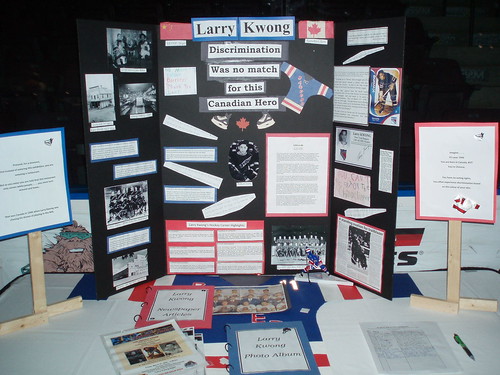

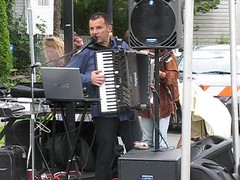


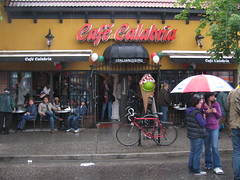
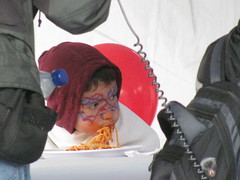
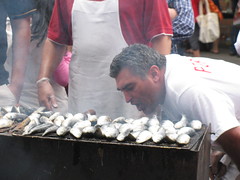
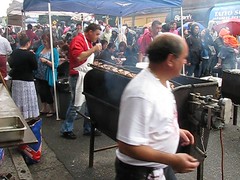


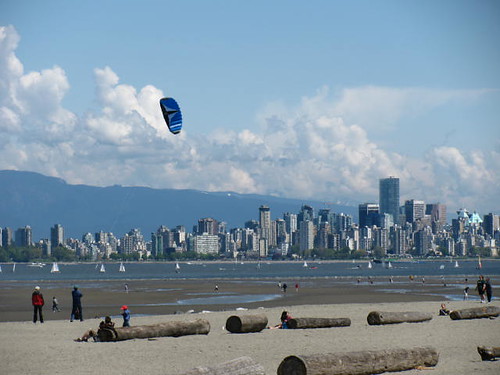 Vancouver is called one of the “most livable cities”
Vancouver is called one of the “most livable cities”
